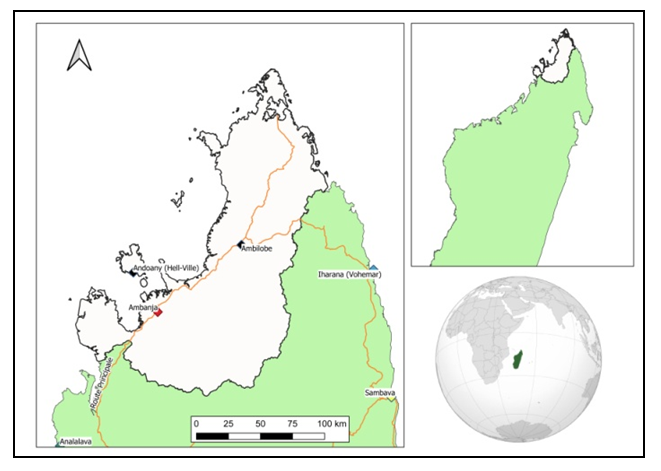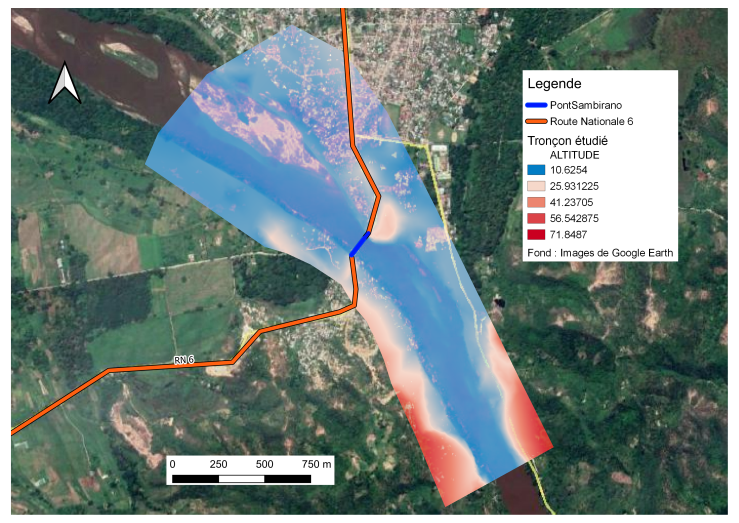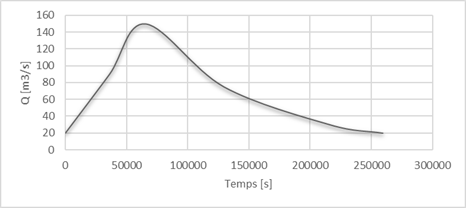-
Paper Information
- Paper Submission
-
Journal Information
- About This Journal
- Editorial Board
- Current Issue
- Archive
- Author Guidelines
- Contact Us
International Journal of Hydraulic Engineering
p-ISSN: 2169-9771 e-ISSN: 2169-9801
2020; 9(2): 25-29
doi:10.5923/j.ijhe.20200902.01
Received: Dec. 3, 2020; Accepted: Dec. 23, 2020; Published: Dec. 28, 2020

Comparison of Numerical Methods for the SWE: Case of a Section of the Sambirano River, Madagascar
Mamisoa Randriamparany1, Justin Ratsaramody2, Michel Randriazanamparany2
1Thematic Doctoral School – Renewable Energies and Environment, Antsiranana University, Hydraulic Laboratories, Madagascar
2Department of Hydraulics Engineering, Antsiranana University, Country
Correspondence to: Mamisoa Randriamparany, Thematic Doctoral School – Renewable Energies and Environment, Antsiranana University, Hydraulic Laboratories, Madagascar.
| Email: |  |
Copyright © 2020 The Author(s). Published by Scientific & Academic Publishing.
This work is licensed under the Creative Commons Attribution International License (CC BY).
http://creativecommons.org/licenses/by/4.0/

Floods are the most devastating natural disasters in the world. Knowledge and mastery of these phenomena is essential for scientists to guide and help decision makers. In this perspective, we are obliged to solve the Shallow Water Equations (SWE) which governs free surface flows which requires numerical approximations. The solutions obtained depend directly on the methods used. Fortunately, since the advancement of computing, researchers and engineers have continued to develop more and more efficient tools that use different methods. This study proposes to use two popular free software in order to compare the classical methods: finite differences and finite volumes. The finite difference methods consist to make a discretization using a predefined mesh (generally rectangular). The finite volume method consists of discretizing the flow domain into a multitude of control volumes (or cells), then performing mass and momentum balances on these small volumes. The results are the distribution of water depths and the flow velocity field throughout the computational domain, thus leading to knowledge of the spread and the general dynamics of the flood. The analysis is made by modeling a section of the Sambirano river, Madagascar during the flood period with a high resolution DTM (Digital Terrain Model). Studies show that the finite volume method with the use of an unstructured triangular mesh is the most suitable for modeling shallow water flows in a natural environment.
Keywords: Finite Differences, Finite Volumes, Flood, Sambirano, Shallow Water Equations
Cite this paper: Mamisoa Randriamparany, Justin Ratsaramody, Michel Randriazanamparany, Comparison of Numerical Methods for the SWE: Case of a Section of the Sambirano River, Madagascar, International Journal of Hydraulic Engineering, Vol. 9 No. 2, 2020, pp. 25-29. doi: 10.5923/j.ijhe.20200902.01.
Article Outline
1. Introduction
- Since the earliest recorded civilizations, humans have tended to settle near watercourses due to the proximity of water supplies, ecological conditions, biodiversity and benefits for favorable conditions for agricultural activities by [1]. A considerable percentage of people live in flood zones. This explains why millions of people are affected by the floods. People exposed to a disaster suffer not only physical injuries but also lasting psychological damage. For [2] and [3] flood forecasting is one of the fundamental elements in mitigating the economic and social impact of flood damage. Recent research has enabled significant advances in the development of flood forecasting models, for example in [4], [5]. Three categories of models have been advanced such as empirical models which encompass those based on either direct or indirect measurements, hydrodynamic models based on Shallow Water equations and simplified models which can be used for predictions but do not have advantages over details. This study only analyzes the efficiencies of hydrodynamic models according to the numerical methods used. It is obvious that the quality of the result depends more on the input data. But this causes a very important compromise, a fine topography requires a fine meshing which will be sanctioned by a slow calculation or an instability of the numerical scheme. For example [6] developed an urban flood modeling approach combining a LiDAR top view with an SfM (Structure of Motion) observation. The study shows that the technique based on the fusion of LiDAR data and motion observations can be very beneficial for flood modeling applications. The modeling of hydrodynamic phenomena is generally marred by errors that arise from the multiple approximations made at each stage of the construction and application of the models. The complexity of the processes involved leads to the use of simplified mathematical equations involving parameters to be adjusted; these are solved in an approximate way by numerical methods and require measured or estimated variables. In order to control the risks associated with rainy events, it is essential to know the impact of the various uncertainties associated with the model on the estimation of water levels or speeds in sensitive areas. The results of the digital model are compared and evaluated with In Situ observations. The main objective was to analyze the efficiencies of the numerical methods used for the resolution of the 2D Shallow Water equations. Pour cela il a été effectué des comparaisons du niveau de l’eau et de la vitesse dans toutes les grilles de calcul.
2. Materials and Methods
2.1. Shallow Water Equations
- The hydrodynamic models are based on the Shallow Water equations. These equations govern free surface flows. It is therefore imperative to add to the system several conditions to have a well-posed problem. These equations can be organized in the following vector form by [7].
 | (1) |
 In which: h: water depth, t: time, u: flow velocity in the x direction, v: flow velocity in the y direction, g: acceleration of gravity.
In which: h: water depth, t: time, u: flow velocity in the x direction, v: flow velocity in the y direction, g: acceleration of gravity.2.2. Site Studied and Data
- The study area is located in the northwestern part of Madagasca (Figure 1). The Sambirano River drains a 2.830 km2 watershed with an average interannual rainfall, estimated at 2.500 mm. This information is listed in [8].
 | Figure 1. Global location of the studied site |
 | Figure 2. Topography and bathymetry of the section studied |
 | Figure 3. Hydrograph at the entry of each model |
2.3. Description of Numerical Methods and Software
- The software we will be using are free solvers embedded in simple and popular graphical interfaces (Best Open source Software in Water Resources). Each solver is implemented for a real case, that is to say the same geometry. The solvers used are listed in table 1:
|
 | Figure 4. Summary of the methods and software used |
 | Figure 5. Left: calculation grid for BASEMENT (unstructured triangular) and calculation grid for Nays2D flood (curvilinear quadrangle) |
2.4. Simulations Implementation
- For the finite difference method, the simulation was carried out with the Nays2D Flood version 5.0 solver in the iRIC software suite version 2.3.9.6034 and with the following characteristics:- A grid of 251 * 31 or 7781 meshes- No calculation time Δt = 0.1- Maximum number of iterations for the calculation of the surface: 10- Minimum water depth: 0.20 mFor the finite volumes method we used BASEMENT 2.8 with the following characteristics:- A grid of 17351 meshes- A CFL condition of 0.8- An exact type Riemann solver with an explicit scheme- Minimum water depth: 0.20 m
3. Results and Discussions
- The following figures show the depths of the flow at different times in the hydrograph. The images on the left relate to the results obtained using BASEMENT while the images on the right using IRIC, at the same time. The figures on the left show the water depths obtained with BASEMENT and those on the right by IRIC.
 | Figure 6. Water depth in the domain at t = 7200s |
 | Figure 7. Water depth at the peak of the hydrograph t = 80400s |
 | Figure 8. Water depth during recession at t = 145200s |
4. Conclusions
- Thanks to advances in the field of digital hydraulics, engineers and researchers are constantly improving the different methods and approaches in order to facilitate and get closer to reality in terms of modeling. This advance has given us the choice for interesting applications such as floods. The objective of this article was then to use the two usual numerical methods for solving flow equations in two-dimensional formulation in order to assess their relevance. Simulation results have shown that both methods can be used for solving the Shallow Water Equation using a high resolution digital terrain model. For the two methods the implicit algorithm allows more important computation time steps than the explicit methods. For the finite difference method the mesh is not necessarily orthogonal but if the mesh is orthogonal the algorithm is simpler and more efficient. The finite volume method provides increased stability and improved robustness over traditional finite difference and finite element techniques.
 Abstract
Abstract Reference
Reference Full-Text PDF
Full-Text PDF Full-text HTML
Full-text HTML